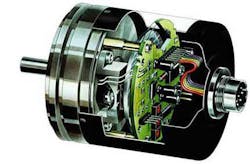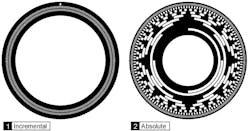What’s the Difference Between Absolute and Incremental Encoders?
According to a report from Questale Market Research, the global motion control encoder market is expected to significantly grow by 2022. The major industries that will be impacted by this growth will be in consumer electronics, industrial automation electronics, chemical manufacturing, and aerospace and defense technology. As noted in the report, the major players in this growth will be:
Rotary encoders connect to a shaft and, as the shaft rotates, the encoder outputs pulses. These are used to determine the speed of the object. By counting the amount of pulses per one full turn of the shaft, one can calculate the resolution. Encoders typically supply square-wave signals in two channels that are offset or out of phase from each other by 90 deg. Each increment of rotation spurs an output signal.
Absolute Encoders
The advantage of absolute rotary encoders is that they provide unique position values as soon as they are switched on by scanning the position of a coded element.
Absolute encoders have an encoder disc which has marks or slots on a power-transmission shaft and a stationary pickup. The disc records a unique code for each shaft position. Each position corresponds to a unique code, and even movements that occur while there is no power are recorded into accurate position values once the encoder is turned on again.
There are two types of absolute encoders: single-turn and multi-turn encoders. Single-turn encoders measure displacement in one turn or across 360 deg. from a starting position. The output is repeated for every revolution. Multi-turn encoders measure in the same fashion as single-turn, but also track the number of total revolutions of the shaft using a unique word for each position and number of revolutions.
Absolute rotary encoders are preferred when safety is a concern, because they position themselves when the machine is powered on. Single-turn are useful for short travel situations. Multiple-turn are better for more complex or longer positioning situations. The latter record position data electronically, typically in binary format. Being resistant to electrical noise is another advantage. However, absolute rotary encoders typically cost more than incremental encoders.
Absolute Rotary Encoder Advantages
- Remembers its position after a power outage and offers continuous position monitoring
- Typically have speed, scaling, preset, and fieldbus functions
- Allow you to determine the exact position of a machine and control over the storage of electronic data
- Multiple interface options: Analog, Ethernet, Fieldbus, Parallel, Serial
- Single-turn and Multi-turn revolution options available
- Optical a magnetic measuring principle
- Absolute encoders have a resolution of up to 16 bits, or 65,536 pulses per revolution (PPR).
Incremental Encoders
The output signal of incremental encoders is generated each time the shaft rotates a certain amount and the resolution of the device is defined by the number of signals per turn. Each time the encoder is powered on it begins counting from zero, regardless of where the shaft is or its previous position. It is necessary for a reference point to be determined in all positioning tasks, both in the startup of the control system and when the power to the encoder has been disrupted. It is necessary for incremental encoders to re-home upon the reference point when powered down.
Rotary incremental encoders store the data in an external buffer or counter. Battery backups can help eliminate the need for re-homing after planned or unplanned shutdowns. Incremental encoders are typically simpler to use and cheaper than absolute encoders.
Incremental Rotary Encoder Advantages
- Good for simple pulse counting or frequency monitoring applications such as speed, direction, and position monitoring
- More cost-effective and less complex than an absolute encoder
- A, B, Z, and inverted signals as HTL (Push-Pull) or TTL (RS422).
- Any pulse count up to 16384 PPR available
- Flexible scaling functionality
- Magnetic measuring principle
- Incremental encoders have a resolution of up to 50,000 PPR.




